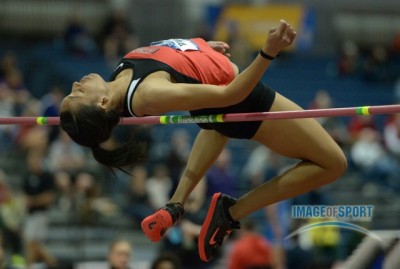Observations on the Women’s NCAA Indoors Entries: An SEC Slugfest in the Team Race
By LetsRun.com
March 4, 2015
Last night, the NCAA announced the list of qualifiers to the 2015 NCAA Division I Indoor Track & Field Championships, to be held March 13-14 at the University of Arkansas. We’ve looked the over the women’s entries and have a few thoughts.
*Men’ entries.*Men’s analysis: Observations on the Men’s NCAA Indoors Entries: Oregon vs. Florida in team race + What does it take to get in?
Women’s competition
Scored track meets can be hard to follow, but we’ve done our best to give you a starting point by scoring the meet based on the entry lists. To create the chart below, we simply looked at the entries and assigned points to the top eight seeds according to the 10-8-6-5-4-3-2-1 scoring system used at NCAAs. In the event of a tie, we split the points as the NCAA would (eg. if two athletes tied for seventh, each would earn 1.5 points). We’ve listed the top five women’s teams below.
| Event | Arkansas | Georgia | Kentucky | Florida | Texas |
| 60 | 6 | 3 | 2 | ||
| 200 | 4 | 13 | |||
| 400 | 6 | 14 | |||
| 800 | 8 | ||||
| Mile | |||||
| 3000 | 10 | ||||
| 5000 | 1 | 2 | |||
| 60 hurdles | 10 | 8 | 5 | ||
| 4×400 | 6 | 5 | 8 | 10 | |
| DMR | 3 | ||||
| HJ | 16 | ||||
| PV | 9 | 3 | 5 | ||
| LJ | 4 | 14 | |||
| TJ | 6 | 10 | 1 | 8 | |
| SP | |||||
| WT | 1 | ||||
| Pentathlon | 3 | 12 | 1 | ||
| TOTAL | 52 | 45 | 41 | 41 | 38 |
Here are the events in which each school has an athlete(s) entered but not projected to score:
Arkansas: 400 (#11), pole vault (#15), long jump (#14), pentathlon (#13, #14)
Georgia: long jump (#13)
Kentucky: 200 (#14), 400 (#13), 60 hurdles (#16)
Florida: 400 (#10), 800 (#10), high jump (#11), long jump (#16), triple jump (#12), weight throw (#16)
Texas: 200 (#12)
- Projected scores give the nod to the home team, but the team competition once again figures to be very close. At last year’s championships, just 3.5 points separated first and fourth, with Oregon edging Texas for the title by half a point as it all came down to the 4×400 relay. The 4×400 could once again be very important as Texas, Florida, Arkansas and Kentucky are the top four seeds in that event (Georgia did not qualify a team).
- Though team conference results aren’t as indicative of NCAA success in track as they are in cross country (XC teams generally run the same athletes at NCAAs as they do at conference; track squads shrink as athletes must qualify individually to NCAAs), it means something that Arkansas won the SEC meet handily last weekend. The Razorbacks won with 130 points to Florida’s 86; Texas A&M was third with 81.9, while Kentucky was only third on its home track with 76. The SEC, with the top four projected teams in the NCAA standings, is clearly the nation’s premier track conference and if Arkansas can dominate the SEC Championships, it bodes well for the Hogs’ NCAA chances.
-
Did Georgia leave points on the board by only entering Kendell Williams in one event? In Williams, Georgia has one of the world’s best young athletes. How good is Williams? She won NCAAs in the pentathlon (indoors, setting the collegiate record in the process) and heptathlon (outdoors) last year as a freshman and then won World Juniors — in the 100-meter hurdles. She also has the #2 time in history for a junior in the 100m hurdles — 12.89 seconds. On the NCAA lists this year, Williams was #16 in the 60 hurdles, #8 in the high jump and #3 in the long jump in addition to being #1 in the pentathlon. The pentathlon is obviously a grueling event, especially for a 19-year-old, but with the long jump on Friday and the pentathlon on Saturday, it doesn’t make much sense as to why Georgia would only enter Williams in the pentathlon when the Bulldogs have a legitimate shot at the team title. Assuming she’s healthy, taking a maximum of six jumps on Friday shouldn’t tire Williams out that much, and the rewards are potentially huge (if Williams finished third in the LJ, as she is seeded, Georgia would move to 51 projected points, just one behind Arkansas).
*MB: Georgia women are in hunt for 2015 NCAA track title – Why isn’t Kendall Williams doing something besides just the multi? - Just as they do on the men’s side, Florida has a very balanced team with entrants in 11 of the 17 events.
- Oregon’s streak of five straight titles looks likely to come to an end. The Ducks are only projected to score 28 points this year, which doesn’t look good enough to contend for the win. Oregon was hurt by the graduation of Phyllis Francis (400 champ who also anchored the winning 4×400) and Laura Roesler (800 champ and ran leg on 4×400), two all-time collegiate legends.
- Amazingly, if Arkansas were to win the team title, it would be the first women’s track title (indoors or outdoors) for the Razorbacks. If they want to get on the men’s level, they’ve got some catching up to do: the Arkansas men have 20 indoor titles in addition to 12 outdoor crowns.
- A team title for Georgia or Kentucky would be the first for either school in track and field, men’s or women’s, indoors or outdoors. Texas last won an indoor women’s title in 2006, Florida in 1992.
- As we mentioned on the messageboard and in the Week That Was, Iona’s NCAA XC champ Kate Avery will not run NCAA indoors as she is competing at this weekend’s European Indoor Championships in Prague instead (she’s running the 3000). Heading into the season, it looked like Avery vs. Emily Sisson was going to be a great 5000 showdown, but it was clear that wasn’t going to happen last weekend as Avery didn’t run a 5000 all year (meaning she had no qualifier). Meanwhile, Sisson is a huge favorite in the 5000 after her 15:12.22 collegiate record at Big Easts last week. The #2 woman on the collegiate list at 5000, Sarah Disanza of Wisconsin (15:20.57), has raced just twice since December (once on a DMR in January, then last weekend at Big 10s where Rachele Schulist beat her by 15 seconds in the 3000). Likewise, the #3 woman, Liv Westphal (15:31.62) ran very fast at the same meet as Sisson and Disanza in December but was only fifth at ACCs in the 3000. After that, no one else has broken 15:40 this year.
- What does it take to get to NCAAs? We’ve run through the last five editions of the championships and posted the time of the final qualifier in each of the women’s distance events below. In the final column, we’ve put the qualifying standards for the 2015 USATF Indoor Championships for comparison — aside from the mile, it was much easier to make USA indoors than NCAA indoors this year.
| Event | 2011 | 2012 | 2013 | 2014 | 2015 | 2015 USA indoors |
| 800 | 2:05.80 | 2:05.32 | 2:06.03 | 2:05.77 | 2:04.87 | 2:06.00 |
| Mile | 4:39.82 | 4:38.87 | 4:37.91 | 4:38.03 | 4:40.69 | 4:35.00 |
| 3000 | 9:15.39 | 9:11.49 | 9:09.48 | 9:10.40 | 9:08.91 | 9:27.00 |
| 5000 | 16:09.64 | 16:03.66 | 15:56.42 | 16:03.12 | 16:02.54 | 16:18.50 |
| DMR | 11:09.67 | 11:04.31 | 11:06.46 | 11:11.69 | 11:05.38 | N/A |




